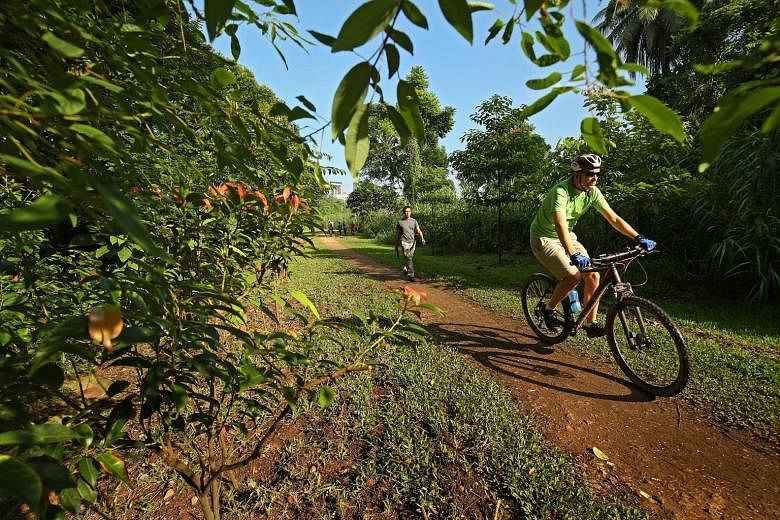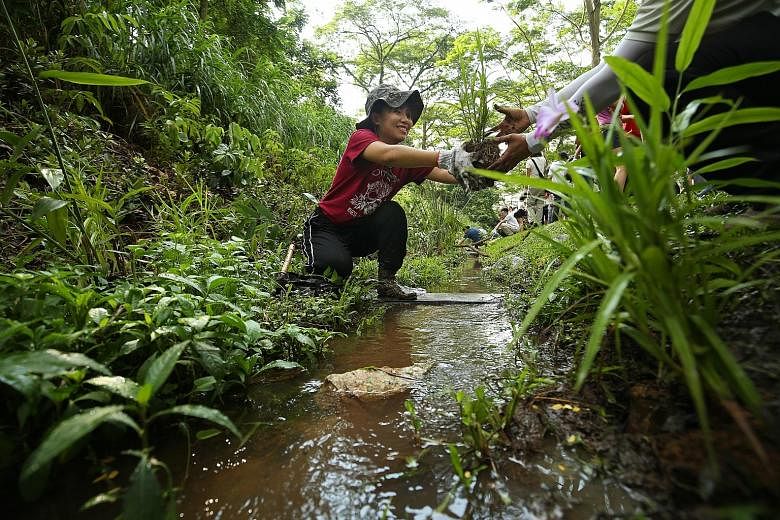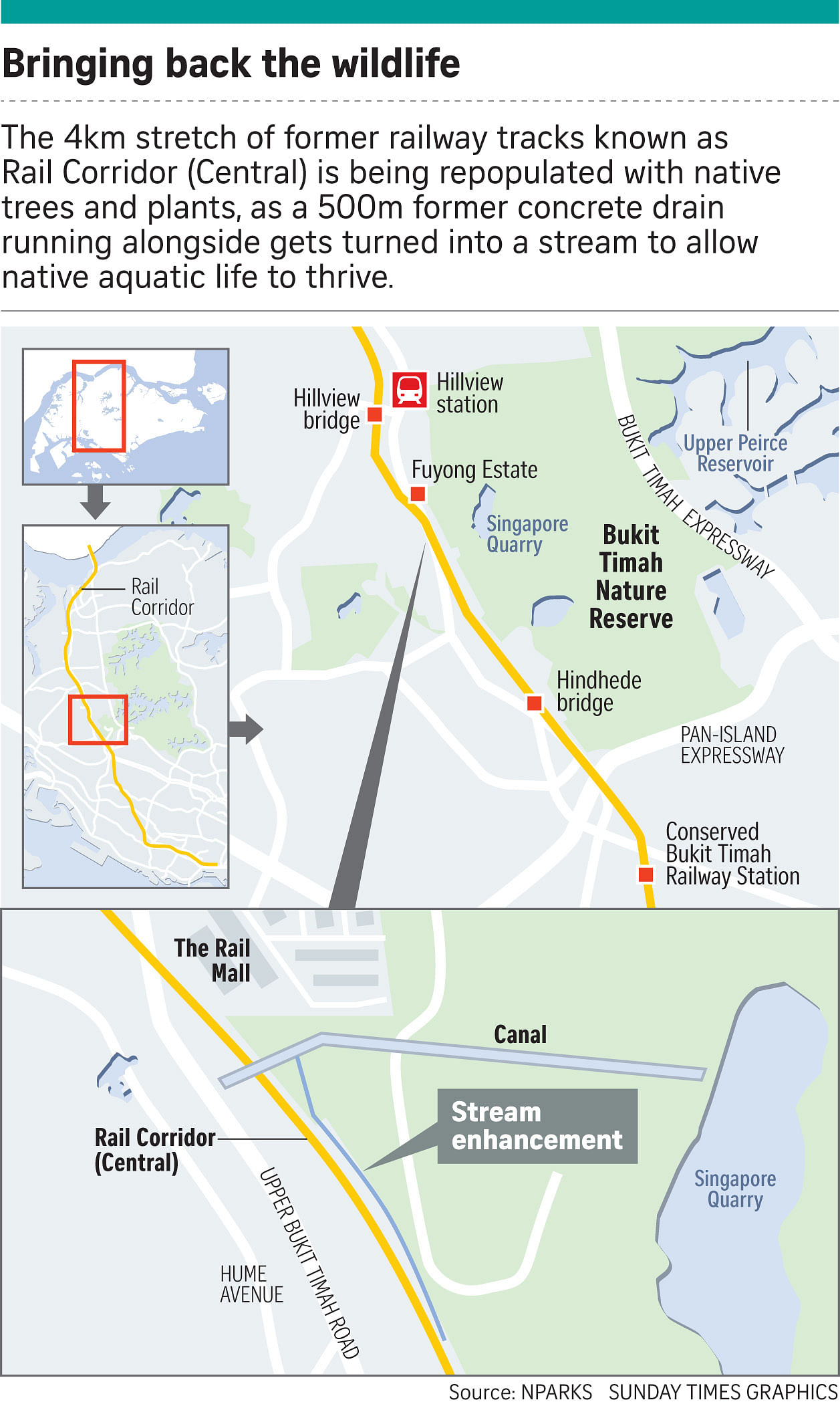Only four Magnolia singapurensis trees are known to exist in Singapore's forests, but yesterday the critically endangered plant's numbers received a boost when two young trees were planted along a disused rail corridor converted to recreational use.
The Rail Corridor stretches from Woodlands to Tanjong Pagar. It was formerly a railway line used for commuting and transporting goods between Singapore and the rest of the Malay peninsula.
Some 200 volunteers planted many more trees and helped to restore a stream, marking the official launch of a movement to reintroduce Singapore's native wildlife to the colonial-era tracks.
By 2021 the 24km length of the Railway Corridor will be ready as a "green vein" that runs vertically through Singapore's west, while a core 4km section near the central catchment area will be cleared of alien trees and be filled instead with native plants, said the director of NParks' central nature reserve department, Ms Sharon Chan.
The National Parks Board (NParks) will lead the process, known as "rewilding", while the Urban Redevelopment Authority (URA) will continue to upgrade the footpaths along the corridor.
Right now, the dirt paths turn to mud after wet weather, which drives people to tread on the grass verges, trampling the wildlife in the process, and inadvertently creating an even wider path that turns into more mud in the rain. URA will solve this by reinforcing the trail near the Bukit Timah Nature Reserve with materials like gravel.
The two agencies have chosen the 4km stretch known as Rail Corridor (Central), which is roughly book-ended by the Hillview and King Albert Park MRT stations.
The section is well used, given its proximity to the Bukit Timah Nature Reserve and heritage landmarks like the black railway bridge, popular with photographers.
Ms Chan said at the launch the board would focus not just on reintroducing native wildlife to the Rail Corridor, but also clearing the alien species that have encroached on the land over the decades.
Pointing to the towering Albizia trees along the sides of the former tracks, she said: "These are from South America, and they have shallow roots that could cause them to topple during storms." These trees, which grew from seeds that were dispersed naturally, will be replaced with native species such as the oil fruit tree and the jelutong.
Ms Chan said the re-population would have to be done gradually to avoid losing the shade the trees provide by removing them too rapidly.
At the same time, NParks will enhance a nearby stream that was originally a concrete drain about a century ago. Its walls have collapsed and the water is full of sediment and silt.
Volunteers and NParks staff will place rocks in the stream and introduce specific plants to filter and clarify the water, creating different habitats for the species found in it such as the common walking catfish and lowland freshwater crab.
Mr Elliott Ong, 21, a volunteer with the Friends of Rail Corridor group, said he counted 10 species of the dragonfly and damselfly in surveys conducted last year.
"We're passionate about the environment, and Singapore has very few natural streams left. This is a way to gain back some of that heritage," said the environmental studies student at the National University of Singapore.
Ms Chan said: "What we hope is to eventually see a water hen coming here, or monitor lizards. Because that means that we would have succeeded in creating a habitat that attracts them."
From January, Rail Corridor (Central) will be closed in phases to allow URA to upgrade the paths. Work on the 4km stretch will be done by December next year.
Speaking at the launch ceremony at Fuyong Park near The Rail Mall yesterday, Holland-Bukit Timah GRC MP Christopher de Souza said: "We want to bring back some of our endangered species and make this a lush, rustic, natural and historical part of Singapore... This stretch really embodies a really important part of our history."
Helping to plant trees yesterday were investment manager Chew Wee Kee and housewife Tiffany Hor, who brought along their young son and daughter as well.
"It's good for the kids to come here and plant some trees to help them understand about sustainability," said Mr Chew, 41. "We want to do our part to make sure that it's still there in the next 50 years."
Other guests at the opening included Second Minister for National Development Desmond Lee, who is also Minister for Social and Family Development, and Holland-Bukit Timah GRC MPs Sim Ann and Liang Eng Hwa.
- Members of the public who wish to contribute to the restoration of the Rail Corridor, or are interested in the guided walks, can find out about the Friends of Rail Corridor group at www.nparks.gov.sg/railcorridor/ friends-of-rail-corridor




